Anton Model, born 31 December 1943
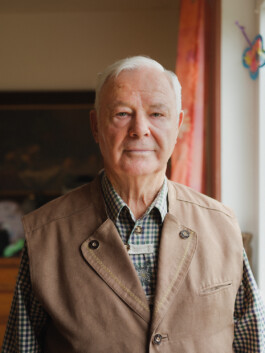
Anton's story
Anton Model grew up on an orchard and winery in Hagnau on Lake Constance. As a nature-loving child, he helped out at an early age. He loved singing and was a committed boy scout. When he was 12 years old, he found documents in his parents’ bedside table revealing that he had been adopted and that his biological mother was Varga Taran from Ukraine. Anton was confused, but kept his discovery to himself. He trained as an orchardist, got married, and took over the parental farm. It was not until the 1980s that Anton began searching for his biological parents. With the help of various organisations and archives, he found their addresses. To his astonishment, his father lived not far away. Soon Anton had the courage to visit him. Anton’s father was delighted with the visit and officially acknowledged his paternity in 1984. Anton’s search for his mother in the Soviet Union was much more difficult. It was not until 1993 that he found her in Ukraine with the help of his Polish friend and colleague Bogdan Dziwanowski. Anton still remembers the overwhelming feeling when his mother embraced him, then aged 50, with the words, “My child, my child!”.
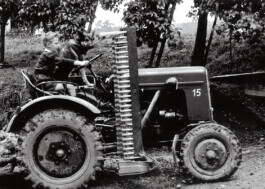
Anton Model in Hagnau, 1955
The picture shows Anton at the age of 11 driving a tractor with the family dog.
Photo: unknown. Private property Model
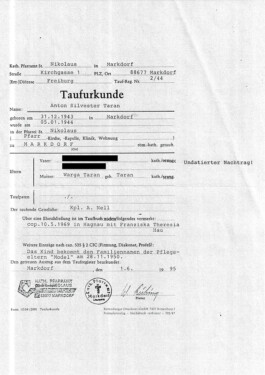
Anton’s christening certificate, 1995
Because he was born on 31 December, his mother Varga gave Anton the middle name of Silvester. He received his surname when he was adopted by the Model couple in 1950.
Private property Model

Anton’s mother Varga in Voronivka, 1993
Warga was the nickname of Warwara Taran, who had taken her husband's surname Kruzilo after their marriage. She died in 2004 at the age of 78.
Photo: unknown. Private property Model
The story of the parents
Varga Taran was deported to the German Reich for forced labour at age 15. She had to work for Anton’s father, who was a widower and looked after his farm and the children on his own. Little is known about Anton’s parents’ relationship. When Varga became pregnant, she was arrested and interrogated by the Gestapo, but released shortly afterwards. After the end of the war, she registered as a displaced person and returned to her home country. It is unclear why Anton stayed in Germany. His mother later told him that the German authorities had forced her to leave him behind. Even before Anton was born, his father was stationed in France as a Wehrmacht soldier, where he was taken prisoner of war in August 1944. After his release, he returned to his farm in spring 1946. He never looked for Varga or his son.
“I have many friends and supporters. Without them, I would never have managed to find my mother.”
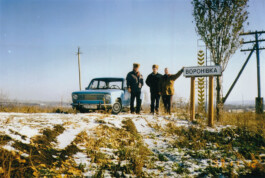
Anton Model with his two Ukrainian brothers-in-law in Voronivka, 1993
Apart from the three years she had to work as a forced labourer in the German Reich, Anton’s mother lived in Voronivka in Ukraine, which was part of the Soviet Union until 1991.
Photo: unknown. Private property Model
Women in forced labour
In September 1944, around a third of those conscripted into forced labour in the German Reich were women. They were mainly forced to work in agriculture and as domestic servants. They were subject to the same discriminatory regulations as men, but were also affected by gender-specific disadvantages. They had hardly any legal defences against sexual assault by employers or other workers. Pregnancy was regarded by the Nazi authorities as “sabotage in labour deployment”. Forced labourers were only considered “useful” if they were able to work. Women from Poland and the Soviet Union were at an additional disadvantage because, unlike Western Europeans, they were affected by Nazi racism.
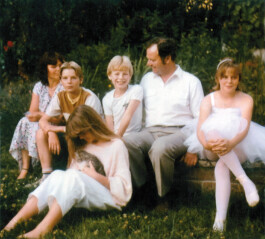
Anton with his wife Franziska and their children, 1986
Photo: unknown. Private property Model
Anton’s big family
Anton Model was able to build up a close relationship with many of his relatives. Until their death, he was in contact with both his adoptive parents and his biological parents. He also had regular contact with his German and Ukrainian half-siblings. Anton and parts of his German family repeatedly visited Ukraine. For Anton’s children, growing up in a bi-national extended family was a matter of course. As a child, his son Franz, who accompanied Anton to Ukraine several times, was even surprised that other children did not also have three grandfathers. Anton still regularly calls his half-sister Tanya Kiyan in Ukraine. Her son spent several months with the Models in 2022 and visited Anton for his 80th birthday.
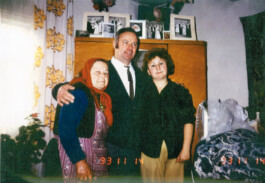
Varga Taran, Anton, and Anton’s half-sister Tanya in Voronivka, 1993
Photo: unknown. Private property Model
Interview
Anton Model, born 31 December 1943

Anton's story
Anton Model grew up on an orchard and winery in Hagnau on Lake Constance. As a nature-loving child, he helped out at an early age. He loved singing and was a committed boy scout. When he was 12 years old, he found documents in his parents’ bedside table revealing that he had been adopted and that his biological mother was Varga Taran from Ukraine. Anton was confused, but kept his discovery to himself. He trained as an orchardist, got married, and took over the parental farm. It was not until the 1980s that Anton began searching for his biological parents. With the help of various organisations and archives, he found their addresses. To his astonishment, his father lived not far away. Soon Anton had the courage to visit him. Anton’s father was delighted with the visit and officially acknowledged his paternity in 1984. Anton’s search for his mother in the Soviet Union was much more difficult. It was not until 1993 that he found her in Ukraine with the help of his Polish friend and colleague Bogdan Dziwanowski. Anton still remembers the overwhelming feeling when his mother embraced him, then aged 50, with the words, “My child, my child!”.

Anton Model in Hagnau, 1955
The picture shows Anton at the age of 11 driving a tractor with the family dog.
Photo: unknown. Private property Model

Anton’s christening certificate, 1995
Because he was born on 31 December, his mother Varga gave Anton the middle name of Silvester. He received his surname when he was adopted by the Model couple in 1950.
Private property Model

Anton’s mother Varga in Voronivka, 1993
Warga was the nickname of Warwara Taran, who had taken her husband's surname Kruzilo after their marriage. She died in 2004 at the age of 78.
Photo: unknown. Private property Model
The story of the parents
Varga Taran was deported to the German Reich for forced labour at age 15. She had to work for Anton’s father, who was a widower and looked after his farm and the children on his own. Little is known about Anton’s parents’ relationship. When Varga became pregnant, she was arrested and interrogated by the Gestapo, but released shortly afterwards. After the end of the war, she registered as a displaced person and returned to her home country. It is unclear why Anton stayed in Germany. His mother later told him that the German authorities had forced her to leave him behind. Even before Anton was born, his father was stationed in France as a Wehrmacht soldier, where he was taken prisoner of war in August 1944. After his release, he returned to his farm in spring 1946. He never looked for Varga or his son.
“I have many friends and supporters. Without them, I would never have managed to find my mother.”

Anton Model with his two Ukrainian brothers-in-law in Voronivka, 1993
Apart from the three years she had to work as a forced labourer in the German Reich, Anton’s mother lived in Voronivka in Ukraine, which was part of the Soviet Union until 1991.
Photo: unknown. Private property Model
Women in forced labour
In September 1944, around a third of those conscripted into forced labour in the German Reich were women. They were mainly forced to work in agriculture and as domestic servants. They were subject to the same discriminatory regulations as men, but were also affected by gender-specific disadvantages. They had hardly any legal defences against sexual assault by employers or other workers. Pregnancy was regarded by the Nazi authorities as “sabotage in labour deployment”. Forced labourers were only considered “useful” if they were able to work. Women from Poland and the Soviet Union were at an additional disadvantage because, unlike Western Europeans, they were affected by Nazi racism.

Anton with his wife Franziska and their children, 1986
Photo: unknown. Private property Model
Anton’s big family
Anton Model was able to build up a close relationship with many of his relatives. Until their death, he was in contact with both his adoptive parents and his biological parents. He also had regular contact with his German and Ukrainian half-siblings. Anton and parts of his German family repeatedly visited Ukraine. For Anton’s children, growing up in a bi-national extended family was a matter of course. As a child, his son Franz, who accompanied Anton to Ukraine several times, was even surprised that other children did not also have three grandfathers. Anton still regularly calls his half-sister Tanya Kiyan in Ukraine. Her son spent several months with the Models in 2022 and visited Anton for his 80th birthday.

Varga Taran, Anton, and Anton’s half-sister Tanya in Voronivka, 1993
Photo: unknown. Private property Model
Interview
nevertheless here!—Children from forbidden relationships between Germans and prisoners of war or forced labourers is a project of the Sandbostel Camp Memorial sponsored by the Foundation Memory, Responsibility, and Future (EVZ Foundation) and the German Federal Ministry of Finance according to the Education Agenda NS-Injustice.
Cooperative partners are the Neuengamme Concentration Camp Memorial, the project Multi-peRSPEKTif (Denkort Bunker Valentin / Landeszentrale für politische Bildung Bremen) and the Competence Center for Teacher Training Bad Bederkesa.

nevertheless here!—Children from forbidden relationships between Germans and prisoners of war or forced labourers is a project of the Sandbostel Camp Memorial sponsored by the Foundation Memory, Responsibility, and Future (EVZ Foundation) and the German Federal Ministry of Finance according to the Education Agenda NS-Injustice.
Cooperative partners are the Neuengamme Concentration Camp Memorial, the project Multi-peRSPEKTif (Denkort Bunker Valentin / Landeszentrale für politische Bildung Bremen) and the Competence Center for Teacher Training Bad Bederkesa.

